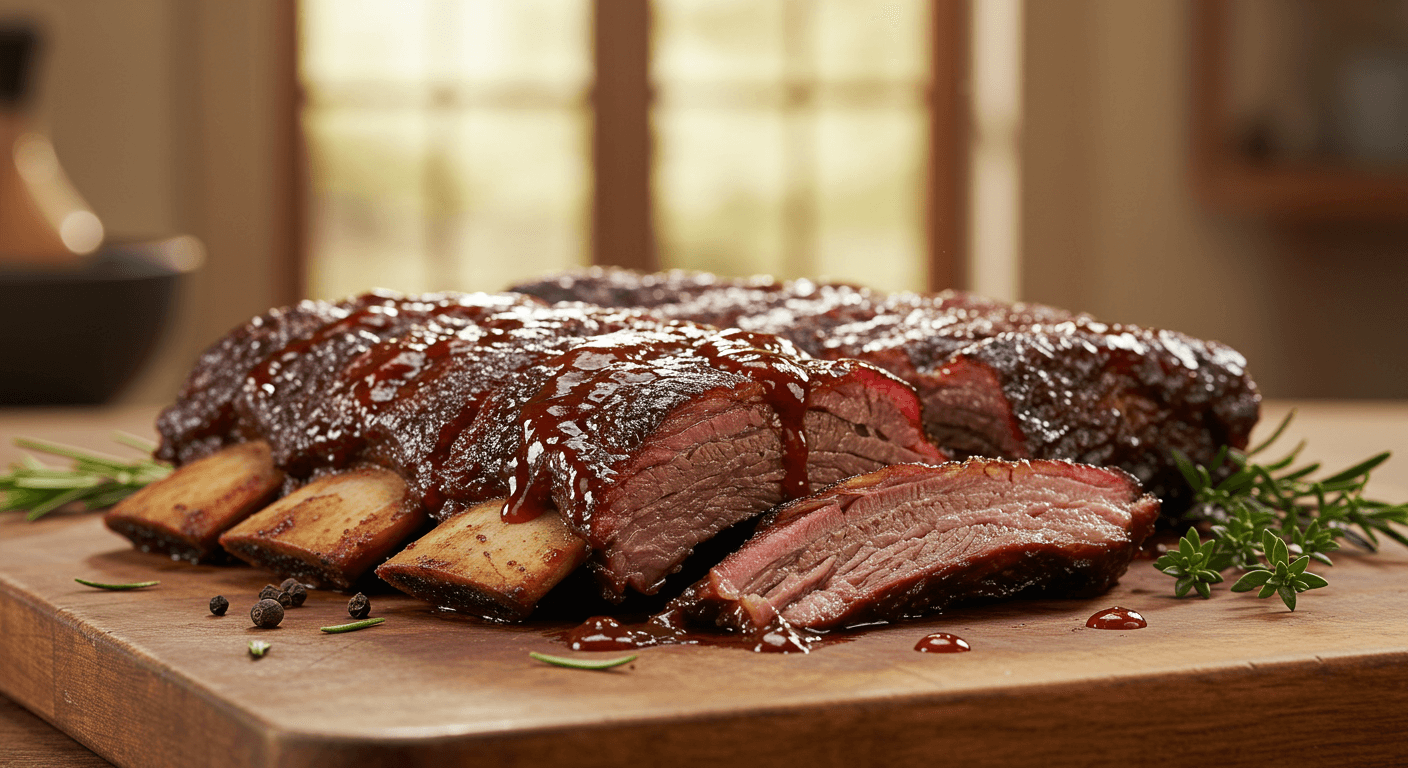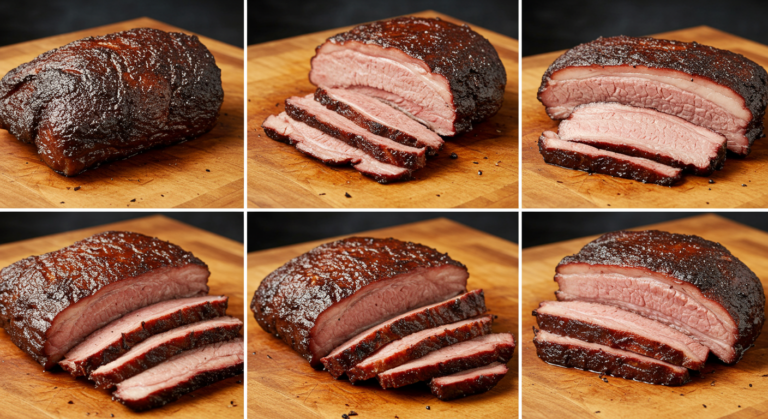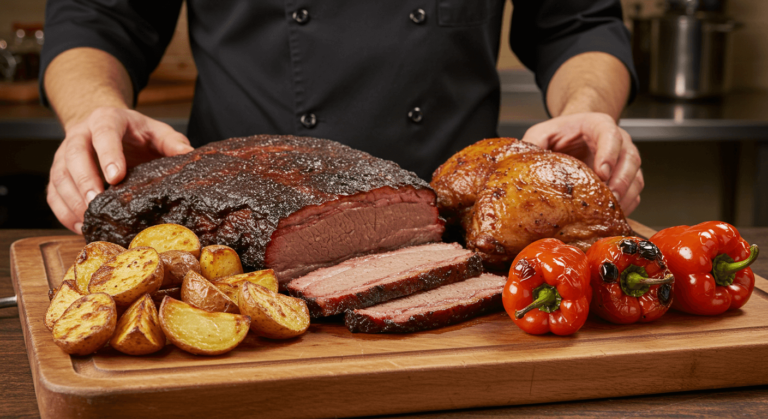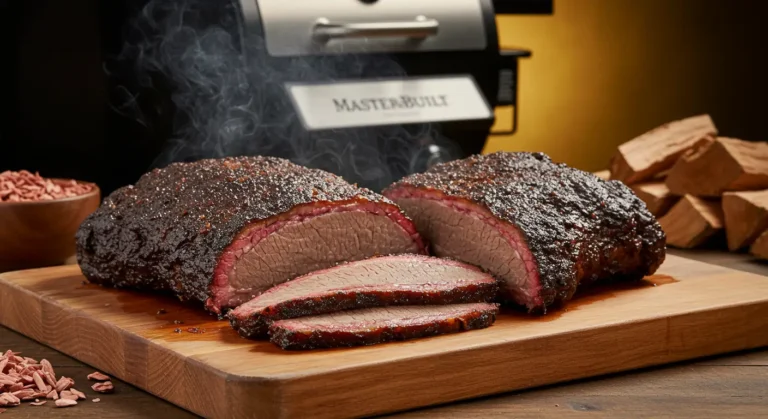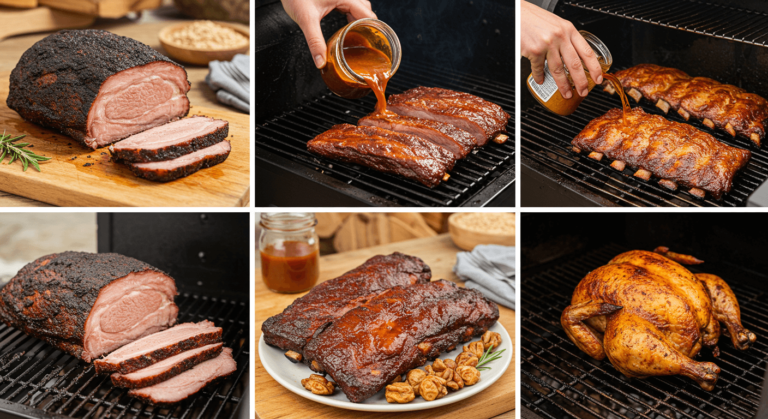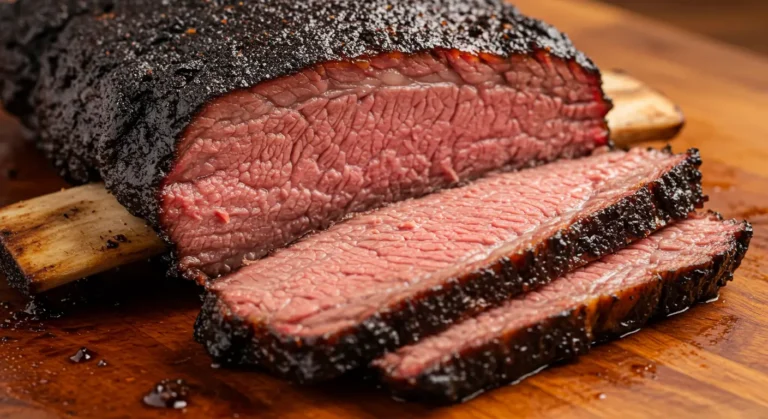How to smoked beef short ribs Perfectly at Home
There’s something almost primal about the first moment you bite into perfectly smoked beef short ribs. That initial crunch of the seasoned bark giving way to tender, juicy meat that practically melts on your tongue. The complex flavors of smoke, beef, and spices dance together in perfect harmony, creating an experience that’s nearly impossible to replicate with any other cooking method.
Welcome to the world of smoked beef short ribs – perhaps one of the most rewarding cuts you can master on your smoker. Whether you’re a weekend warrior who just unboxed your first smoker or a seasoned pitmaster looking to perfect your technique, this comprehensive guide will walk you through everything you need to know about transforming those tough, collagen-rich beef short ribs into mouthwatering morsels of barbecue perfection.
In this guide, we’ll cover selecting the right cut, preparing your ribs, managing your fire, navigating the infamous “stall,” and ultimately achieving that perfect tenderness that makes beef short ribs a true showstopper at any gathering. By the end, you’ll have the confidence and knowledge to smoke beef short ribs like a professional, right in your own backyard.
What Are Beef Short Ribs and Why Are They Perfect for Smoking?
Before diving into technique, let’s understand what makes beef short ribs so special. Unlike their porcine counterparts, beef short ribs come from the plate or chuck section of the cow. They’re characterized by thick layers of meat sitting atop substantial bones, with generous marbling throughout.
“Beef short ribs are the pinnacle of barbecue for many enthusiasts because they deliver everything we love about brisket but in a more manageable package,” says Aaron Franklin, renowned pitmaster and author. “They’ve got that perfect combination of fat, collagen, and muscle that, when cooked low and slow, transforms into something magical.”
This high collagen content is precisely what makes short ribs ideal candidates for smoking. During the long cooking process, that collagen slowly breaks down into gelatin, creating that signature mouthfeel that quality barbecue is known for. The fat content also renders beautifully, basting the meat from within as it cooks.
What Type of Beef Short Ribs Should You Buy?
Plate Short Ribs vs. Chuck Short Ribs
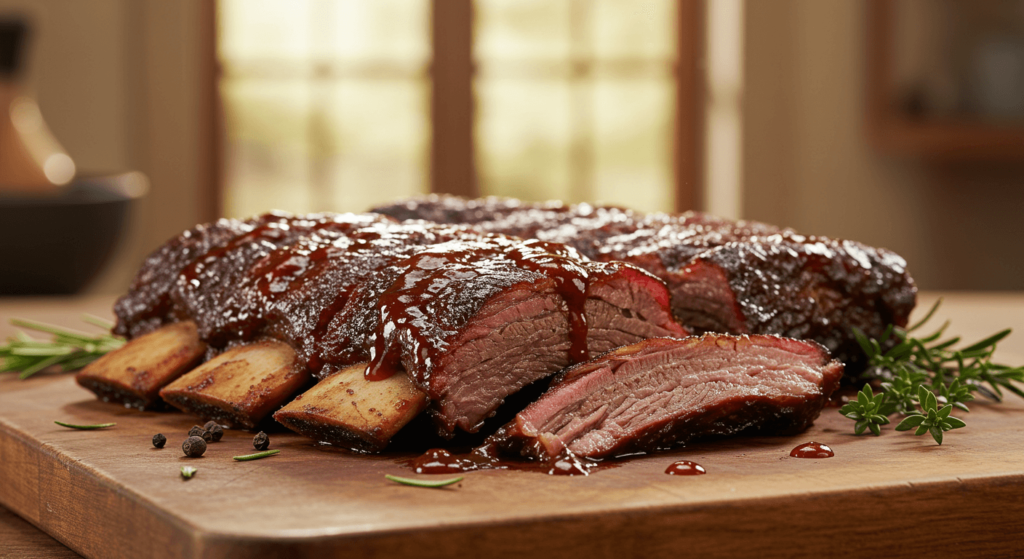
When shopping for beef short ribs, you’ll typically encounter two main varieties:
Plate Short Ribs (NAMP 123) – These come from the lower portion of the rib cage near the belly. Often called “loaded beef ribs” or “dinosaur ribs,” these impressive cuts feature 3-4 bones with thick meat (up to 2 inches) sitting on top. These are the classic “Texas-style” beef ribs you’ll find at famous barbecue joints.
Chuck Short Ribs (NAMP 130) – These come from the upper portion of the rib cage near the shoulder. They tend to be smaller than plate ribs but still offer excellent marbling and flavor. They’re sometimes easier to find at standard grocery stores.
Bone-In vs. Boneless
While boneless beef short ribs are certainly convenient and smoke beautifully, most barbecue purists prefer bone-in ribs. The bones provide several advantages:
- They act as natural heat conductors
- They contribute additional flavor
- They help the meat retain moisture during cooking
- They make for a more impressive presentation
“I always tell people to seek out bone-in ribs whenever possible,” says Jess Pryles, meat expert and cookbook author. “Not only do they cook more predictably, but there’s something ceremonial about picking up that bone and enjoying beef ribs the way they were meant to be eaten.”
What to Look For When Buying Beef Short Ribs
When selecting beef short ribs for smoking, keep these factors in mind:
- Marbling – Look for visible flecks of white fat running through the meat
- Thickness – Ideally, you want at least 1-1.5 inches of meat on top of the bone
- Freshness – The meat should be bright red with no discoloration
- Quality – Prime or Choice grades will offer better marbling than Select
- Size consistency – Try to find ribs of similar size for even cooking
If you can’t find quality short ribs at your local supermarket, consider visiting a butcher shop or ordering from a specialty meat provider online.
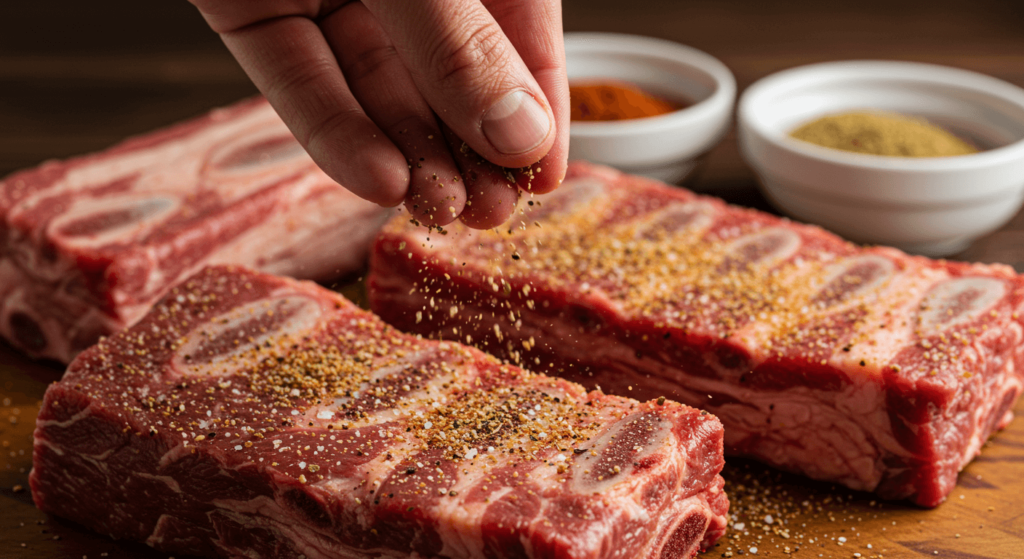
How Should You Prepare Beef Short Ribs for Smoking?
Trimming Your Beef Short Ribs
Unlike brisket, beef short ribs generally don’t require extensive trimming. However, there are a few key steps to prepare them properly:
- Remove the silver skin (the tough membrane) from the bone side if your butcher hasn’t already done so
- Trim any hard chunks of fat on the exterior (but leave the marbling intact)
- If there’s an excessive fat cap (more than ¼ inch), you can trim it down slightly
- Check for and remove any loose pieces of bone or meat
“The beauty of beef short ribs is that Mother Nature did most of the work for you,” explains Steven Raichlen, barbecue expert and author. “Unlike brisket, which requires surgical precision when trimming, ribs just need a little cleanup before they’re ready for seasoning.”
What’s the Best Rub for Smoked Beef Short Ribs?
Traditional Texas-style beef ribs shine with a simple salt and black pepper rub, often called “Dalmatian rub” due to its speckled appearance. This minimalist approach lets the natural beef flavor and smoke shine through.
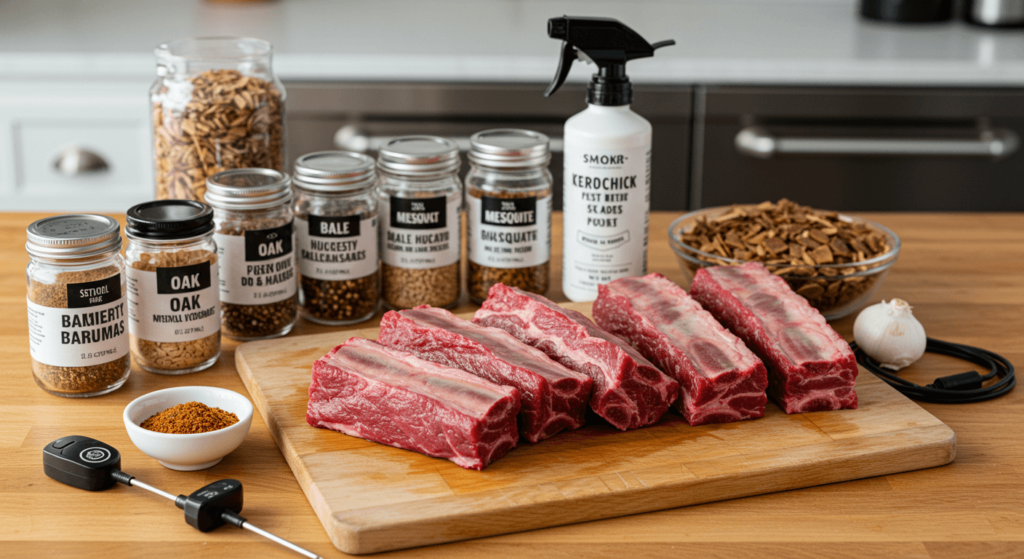
Classic Texas Dalmatian Rub:
- 2 parts coarse black pepper
- 1 part kosher salt
For those who prefer more complexity, here’s an enhanced rub that still complements the beef without overpowering it:
Enhanced Beef Rib Rub:
- 3 tablespoons coarse black pepper
- 2 tablespoons kosher salt
- 1 tablespoon granulated garlic
- 1 tablespoon onion powder
- 1 teaspoon mustard powder
- ½ teaspoon cayenne pepper (optional for heat)
Apply your chosen rub liberally to all sides of the ribs. For the best flavor penetration, season your ribs at least 1 hour before smoking, or ideally, the night before. This early application allows the salt to act as a dry brine, helping the meat retain moisture during cooking.
What’s the Best Wood for Smoking Beef Short Ribs?
The wood you choose will significantly impact the flavor profile of your finished ribs. For beef short ribs, these woods work exceptionally well:
- Oak: The gold standard for beef ribs, providing a medium-strength smoke that complements without overpowering
- Hickory: Stronger than oak with a bacon-like flavor that pairs beautifully with beef
- Mesquite: The boldest option, offering an intensely earthy Texas flavor (use sparingly or mix with milder woods)
- Pecan: A nice middle ground between oak and hickory with subtle sweetness
- Cherry: Milder smoke with slight sweetness that creates a beautiful color
“I’m a firm believer in oak for beef ribs,” says Meathead Goldwyn, barbecue expert and founder of AmazingRibs.com. “It’s like the perfect background music – present enough to enhance the experience without stealing the show from the beef itself.”
What Temperature Should You Smoke Beef Short Ribs?
The sweet spot for smoking beef short ribs is between 250°F and 275°F. This temperature range offers several advantages:
- It’s hot enough to render fat effectively
- It helps develop a beautiful bark
- It’s low enough for the collagen to break down properly
- It provides enough time for smoke flavor to penetrate
While some pitmasters smoke at temperatures as low as 225°F, this extends the cooking time significantly without necessarily improving the final result. On the flip side, temperatures above 275°F risk rendering too much fat too quickly, potentially leaving your ribs dry.
How Long Does It Take to Smoke Beef Short Ribs?
The honest answer: it takes as long as it takes. However, as a general guideline:
- Bone-in beef short ribs typically require 6-8 hours at 250°F
- Boneless beef short ribs usually need 5-6 hours at 250°F
Several factors affect cooking time:
- Size and thickness of the ribs
- Starting temperature of the meat
- Consistency of your smoker’s temperature
- Weather conditions (wind, ambient temperature)
Rather than focusing solely on time, use internal temperature as your primary guide. Beef short ribs are done when they reach an internal temperature of 200-205°F and probe tender (more on this below).
The Smoking Process: Step by Step
Step 1: Prepare Your Smoker
- Clean your grates and remove old ash if necessary
- Fill your water pan if your smoker has one
- Prepare your wood (chunks, chips, or pellets depending on your smoker type)
- Preheat your smoker to 250°F and ensure it’s holding temperature steadily
Step 2: Place the Ribs in the Smoker
- Remove the seasoned ribs from the refrigerator about 30 minutes before smoking
- Place the ribs bone-side down on the grates
- Position them away from direct heat sources
- Insert a temperature probe into the thickest part of the meat (if using one)
Step 3: Maintain Consistent Temperature
- Keep the smoker between 250-275°F throughout the cook
- Add wood as needed according to your smoker type
- Avoid opening the smoker door/lid unnecessarily
- Monitor both the smoker temperature and meat temperature
Step 4: Navigate the Stall
The “stall” is a phenomenon where the internal temperature of your meat seems to stop rising, typically around 150-170°F. This happens as moisture evaporates from the surface of the meat, creating a cooling effect that counteracts the heat from your smoker.
For beef short ribs, you have two primary options:
Option 1: Push Through It Simply maintain your cooking temperature and wait it out. This preserves the maximum smoke flavor and results in the best bark formation. This approach will add 1-3 hours to your cook time.
Option 2: The Texas Crutch Once your ribs hit the stall (around 160°F internal):
- Remove them from the smoker
- Wrap them tightly in butcher paper (preferred) or aluminum foil
- Return them to the smoker
- Continue cooking until they reach the target temperature
Wrapping speeds up the cooking process but may soften the bark somewhat. Many pitmasters view this as an acceptable tradeoff, especially when time is a consideration.
Step 5: Test for Doneness
Beef short ribs are done when three conditions are met:
- Temperature: The internal temperature reaches 200-205°F
- Probe tenderness: A temperature probe or toothpick slides into the meat with little resistance, similar to pushing through soft butter
- Bone movement: The bones move slightly when twisted, indicating the meat is tender but still attached
“Don’t just cook to temperature,” advises Malcom Reed of HowToBBQRight. “Learning to recognize that perfect probe tenderness is what separates good barbecue from great barbecue. The thermometer gets you close, but your sense of touch gets you to the finish line.”
Step 6: Rest Your Ribs
Perhaps the most underappreciated yet crucial step:
- Remove the ribs from the smoker
- If wrapped, keep them wrapped; if unwrapped, loosely tent with foil
- Rest for at least 30 minutes, ideally 1 hour
- For longer rests, wrap in towels and place in a cooler (without ice)
During this rest period, the meat’s juices redistribute, the proteins relax, and carryover cooking completes the tenderization process. Skipping this step risks dry, less tender results.
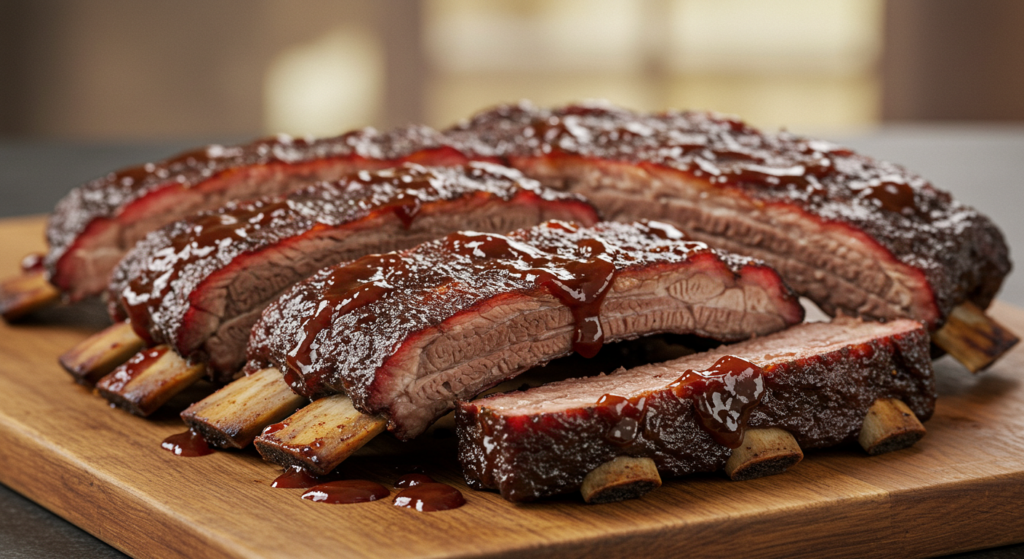
Troubleshooting Common Beef Short Rib Problems
Tough Ribs
Possible causes:
- Undercooked (didn’t reach proper internal temperature)
- Cooked too quickly at high temperature
- Poor quality meat with insufficient marbling
Solutions:
- Continue cooking until probe tender
- Lower your smoking temperature
- Select higher quality ribs with better marbling next time
Dry Ribs
Possible causes:
- Overcooked beyond target temperature
- Too much fat trimmed before cooking
- Cooked at too high a temperature
- Insufficient rest time
Solutions:
- Monitor internal temperature more closely
- Leave more fat on during preparation
- Lower your cooking temperature
- Extend the rest period
Weak Smoke Flavor
Possible causes:
- Not enough wood used during smoking
- Wrong wood type for beef
- Excessive wrapping time
Solutions:
- Add more wood early in the cook (first 3-4 hours is when meat accepts smoke best)
- Switch to stronger wood like hickory or oak
- Delay wrapping until good smoke flavor develops
Beyond the Basics: Advanced Techniques
The Spritz Method
Some pitmasters spritz their beef short ribs during smoking to enhance flavor and promote better bark formation:
- Fill a clean spray bottle with your chosen liquid (beef broth, apple cider vinegar, water, or beer)
- After the first 2 hours of smoking, lightly spritz the ribs every 45-60 minutes
- Apply just enough to moisten the surface without washing away the rub
The Smoked Then Sous Vide Method
For the ultimate control over tenderness:
- Smoke the ribs at 250°F for 3 hours to develop flavor and color
- Vacuum seal the partially smoked ribs
- Sous vide at 155°F for 24-36 hours
- Finish on the smoker for 1 hour to restore the bark
This technique combines the best of both worlds: authentic smoke flavor with precisely controlled tenderness.
Finishing Glazes and Sauces
While purists might scoff, a light glaze applied in the final 30 minutes can add another dimension to your beef short ribs:
Coffee-Bourbon Glaze:
- ¼ cup strong brewed coffee
- 2 tablespoons bourbon
- 2 tablespoons brown sugar
- 1 tablespoon butter
Ancho-Honey Glaze:
- 2 tablespoons honey
- 1 tablespoon ancho chile powder
- 1 tablespoon apple cider vinegar
- 1 teaspoon garlic powder
Brush the glaze on during the last 20-30 minutes of cooking, allowing it to set but not burn.
How to Serve Smoked Beef Short Ribs
Slicing and Presentation
For bone-in ribs:
- Cut between the bones to separate individual ribs
- Serve on a wooden board or platter with the bone as a natural handle
For boneless ribs or when serving from bone-in ribs:
- Slice against the grain in pencil-thickness pieces
- Arrange slices to showcase the smoke ring and bark
“The presentation of beef ribs is half the experience,” says Christie Vanover, pitmaster and founder of Girls Can Grill. “When those massive ribs hit the table with that glistening bark and perfect smoke ring, people’s eyes widen before they even take their first bite.”
Classic Sides for Beef Short Ribs
Complete your smoked beef short rib meal with these traditional accompaniments:
- Creamy coleslaw
- Baked beans
- Potato salad
- Cornbread
- Pickled vegetables (for cutting through the richness)
- Simple green salad with vinaigrette
Wine and Beer Pairings
Beef short ribs pair wonderfully with:
- Bold red wines like Cabernet Sauvignon or Syrah
- Brown ales or porters
- Bourbon or rye whiskey
Frequently Asked Questions About Smoking Beef Short Ribs
Final Thoughts: The Art of Patience
Perhaps the most important ingredient when smoking beef short ribs isn’t found in your spice cabinet – it’s patience. These magnificent cuts transform from tough to transcendent through the slow application of heat and smoke, a process that simply cannot be rushed. beef short ribs smoked ,beef short ribs smoker ,how long to smoke beef short ribs
“Barbecue is the ultimate exercise in delayed gratification,” reflects Pat Martin, renowned pitmaster. “We live in a world of instant everything, but great beef short ribs demand that you slow down and respect time as an essential ingredient.”
So fire up your smoker, prepare your ribs, and settle in for one of the most rewarding experiences in barbecue. The combination of your attention, quality ingredients, and the transformative power of fire and smoke will create beef short ribs that aren’t just a meal, but a memorable celebration of barbecue at its finest.
Whether you’re cooking for family, friends, or simply to perfect your craft, smoked beef short ribs represent the pinnacle of barbecue achievement – and with the techniques in this guide, you’re well on your way to mastering them at home.
Have You Tried This Recipes!
Mouthwatering Smoked Beef Short Ribs – A Flavor Explosion!
I recently tried smoked beef short ribs, and they completely exceeded my expectations! The meat was incredibly tender, with a beautiful smoke ring and a deep, rich flavor. The slow smoking process infused every bite with a perfect balance of smokiness and juiciness, making it fall off the bone effortlessly.
What stood out the most was the texture—crispy on the outside, yet melt-in-your-mouth tender on the inside. The seasoning complemented the natural beef flavor without overpowering it. Paired with a tangy barbecue sauce or a simple salt and pepper rub, these ribs were absolutely unforgettable.

